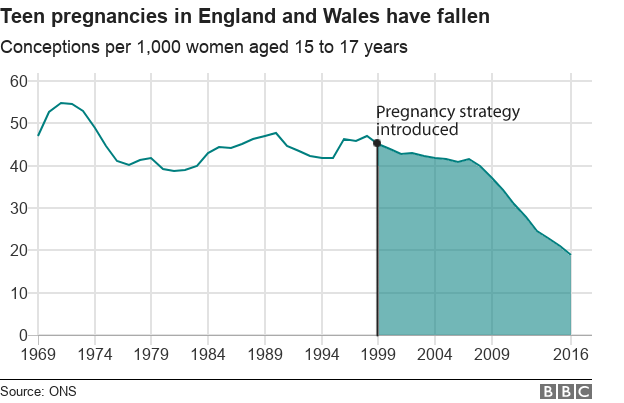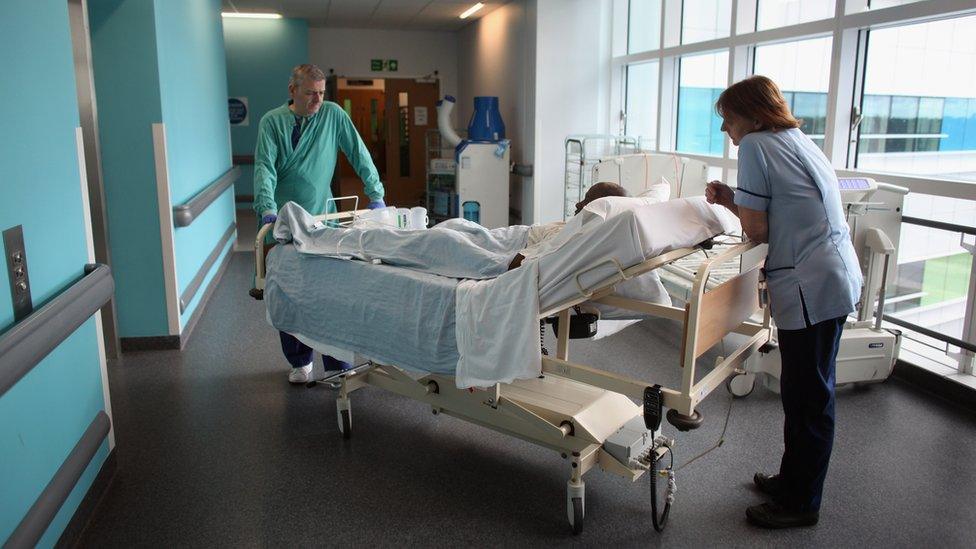Is social media to thank for low teen pregnancy rates?
- Published

It is perhaps one of the great societal success stories of our time.
Over the past 20 years, the teenage pregnancy rate in England and Wales has been more than halved.
It is now at its lowest level since records began, in the 1960s.
If that had been achieved in other areas of public health, such as say obesity, it would be lauded from the rooftops.
Instead, the continued progress is now almost taken for granted after the ninth successive annual fall in rates.
But how has this been achieved?
Are teenagers swapping social media for sex?
In the past it has been suggested the rise of social media is to thank - the idea being that young people are spending more time socialising online.
It is true the biggest drop has been seen in the past 10 years, a period in which social media has transformed the way people socialise and interact.
Research by Ofcom has found that 16- to 24-year-olds spend more than 27 hours a week on the internet - almost three times the amount they did a decade before.
And there is evidence that young people are becoming more responsible than previous generations in other ways. The numbers who don't drink is on the rise.
But Alison Hadley, director of the Teenage Pregnancy Knowledge Exchange at the University of Bedfordshire, says neither of these factors have translated to teenagers of today having significantly less sex.
"The research doesn't show that," she says. "Too much has been made of this idea. I would not discount it entirely. There are going to be a range of factors behind the fall. But I think other reasons are more significant."

Instead, she believes the progress can be tracked back to the 1999 teenage pregnancy strategy, which she helped to implement.
"It was an evidence-based plan so people shouldn't be surprised it that it resulted in progress.
"The aspirations of young people and the attitudes of people have changed. That is what we envisaged when we launched the plan."
Making services more youth-friendly
The Office for National Statistics, which publishes the data, has also given credit to government policies.
The start of the downward trend can be traced back to the late 1990s, when the government started planning the strategy and talking about the issue.
That plan has led to a sustained effort on all sorts of levels.
There has been a big push on improving the quality of sex education in schools, which is now being made mandatory. Access to emergency contraception - also known as the morning-after pill - has been widened too.
Locally, councils and their health colleagues have been looking at ways to make services more accessible and youth-friendly.
You only need to look at some of the areas that have made the most progress to see what has been done.
In Bristol, the council has set up a network of drop-in sessions in secondary schools where pupils are given advice and can get contraception and even tests for sexually transmitted infections.
In Hull a drop-in service was set up in the city centre. Rather than being a traditional clinic-style sexual health service, it installed sofas and a games console to normalise the service and encourage young people to use it.
Similar projects can now be found up-and-down the country.
But for how long?
Isabel Inman, from young people's sexual health charity Brook, is worried cuts to council public health budgets could put services at risk.
And if this is to happen she warns the progress that has been made could be "severely jeopardised".
- Published8 February 2018

- Published7 February 2018
